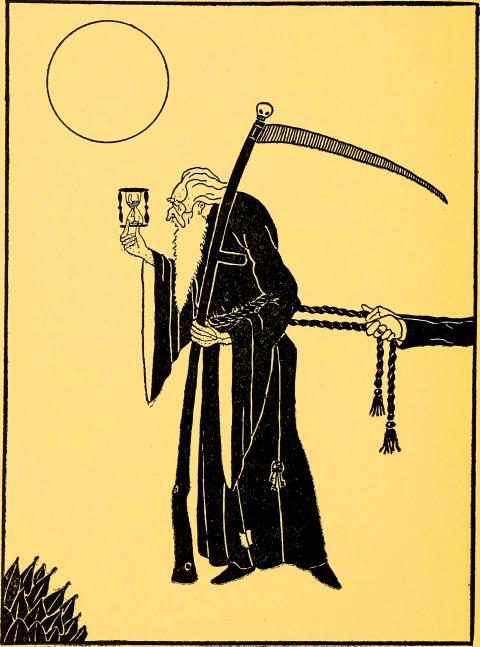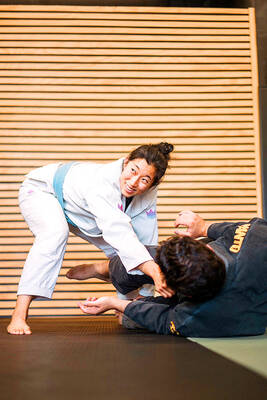Chinese Practice
逝者如斯夫,不舍晝夜
All that passes is like a river,

Photo: Wikimedia Commons
照片:維基共享資源
flowing continuously
(shi4 zhe3 ru2 si1 fu2 bu4 she3 zhou4 ye4)
《論語》〈子罕〉篇有一句寫道:「子在川上曰:逝者如斯夫!不舍晝夜。」意思是說,孔子站在河邊嘆道:「那些流逝的就像這河水,是日日夜夜不斷地在流逝。」後世對這比喻或有不同的詮釋,但「逝者如斯夫,不舍晝夜」這句話現用來指光陰的流逝,以及時間的寶貴。
英文有句類似的說法,也將流水比喻作時間:「time and tide wait for no man」(時間與潮汐是不等人的),意思是說,我們該把握機會,因它可能稍縱即逝。而這句話的演變有些曲折。
此句一般認為出自英國文豪喬叟(西元一三四三~一四○○年)所著,於一三六八年出版的《學者的故事》其中一句:「For thogh we slepe, or wake, or rome, or ryde, Ay fleeth the tyme; it nyl no man abyde 」(因即便我們無論是睡或醒,或漫步,或騎馬,時間永遠在消逝;時間不等任何人)。
但是喬叟所寫下的只有「時間」,他並沒有提到「潮汐」。
紀錄中最早使用「time and tide」(時間與潮汐)的是一二二五年——也就是年代較喬叟早一百多年的聖馬荷的著作中。聖馬荷的生平似乎鮮為人知,他寫道:「你出生的潮汐與時間應受祝福。」此句雖非描述時間之流逝,但其中tide(潮汐)一字便是時間的同義詞。
現今英語中的「tide」一字指海面升降、一天兩次漲退的潮水。但在聖馬荷的年代,「tide」是由古英語字「tid」演變而來,其意為「時間中的一點或一段時間、到期日、時期或季節」。這個字在十四世紀中才有現今的「潮汐」的意義。因此聖荷馬原文中的「time」及「tide」兩個字的意義相同。
因此,後來「time and tide」這說法便結合了喬叟原句的含意,而成了現今的「Time and tide wait for no man」這句話。
(台北時報編譯林俐凱譯)
逝者如斯夫,不舍晝夜。我們該把握時間,趁早努力,以免老大徒傷悲。
(Time and tide wait for no man. We should seize opportunities as they arise, lest we regret lost opportunities in our dotage.)
英文練習
Time and tide wait for no man
In the Zi Han chapter of the Analects of Confucius, it says, 子在川上曰:逝者如斯夫!不舍晝夜. Translated, this means “Confucius, standing on the river bank, lamented: ’that which passes is like this river, flowing unceasingly, day and night’.” While different interpretations of this metaphor have been ventured throughout history, the phrase 逝者如斯夫,不舍晝夜 has come to refer to the passage of time, and of time as something to be valued.
The link between time and water appears in an English equivalent, “time and tide wait for no man,” meaning that one should make use of an opportunity, as you might not have the chance later. The evolution of the phrase, however, is a little complicated.
It is generally attributed to Geoffrey Chaucer (1343-1400) who, in the Prologue to the Clerk’s Tale (1368), wrote “For thogh we slepe, or wake, or rome, or ryde, Ay fleeth the tyme; it nyl no man abyde (For though we sleep or wake, or roam, or ride, time forever flees; it will tarry [wait] for no person.)
But Chaucer only uses the word “time”; he makes no mention of “tide.”
The earliest recorded usage of “time and tide” appears in the writings of a St. Marher — of whom little seems to be known — in 1225, over a century before. Translated into modern English, he wrote, “And the tide and the time that you were born shall be blessed.” Although St. Marher was not talking about the passage of time, he was using a phrase in which tide was equated with time.
The modern usage of “tide” refers to the alternate rising and falling of the surface of the ocean, usually twice a day. In St. Marher’s time, however, it meant “a point or portion of time, due time, period or season,” deriving from the Old English word “tid.” The modern meaning was given to the word in the mid-14th century. Time and tide, in the phrase, are essentially one and the same thing.
This combination was subsequently combined with Chaucer’s allusion to form the modern version of the phrase.
(Paul Cooper, Taipei Times)
You’d better start preparing for the new job. You know what they say about time and tide...
(你最好為新工作及早做好準備。你知道時間是不等人的。)

Picture a 45-foot-long animal with a 5-foot-long skull and 3-foot-long arms. It may not seem strange until you realize that a human with those proportions would be 6 feet tall with 5-inch arms. Although the Tyrannosaurus rex went extinct 65 million years ago, the mystery of its unusual body __1__ has fascinated scientists for over a century. Barnum Brown, the paleontologist who first discovered T. rex fossils, initially found it hard to believe that the tiny arms belonged to such a __2__ creature. One of his colleagues speculated that the short forelimbs might have been used to hold the

A: Actually, Brazilian jiu-jitsu is particularly good for small people like you. B: Really? How so? A: According to Diana Wang, a US doctor of physical therapy, the BJJ’s purpose is to help smaller, weaker people defend themselves by using various techniques, such as leverage. B: That sounds interesting. What time does Dr Wang’s BJJ seminar begin tonight? A: The event is scheduled for 7:30pm at PMA Brazilian Jiu-jitsu in Taipei. Admission is free, but donations are welcome. A: 其實你的個子比較小,很適合練巴西柔術呢。 B: 真的嗎?為什麼? A: 據美國理療醫師王幼瑞博士說,巴西柔術的概念是讓弱小的人,也能利用槓桿作用等技巧防身。 B: 真有趣,王醫師的巴柔研討會幾點開始? A: 今晚7點半在「台北巴柔運動館」,免費入場自由樂捐唷! (By Eddy Chang, Taipei Times/台北時報張迪)

Photographer Franziska Stuenkel likes to take spontaneous urban shots, so she needs a nimble camera that is ready to go when inspiration strikes: her German-made Leica M11. “I have to be very quick and discreet,” said the Berlin-based artist who captures reflections of people walking past windows, their contours merging with the shapes behind the glass. Stuenkel’s compact Leica is the perfect camera for the job, the 51-year-old told AFP. Famous for its pocket-sized and retro-style devices, the Leica brand is celebrating a milestone as it marks 100 years since its first commercial camera was presented to the public. The

Dogs’ noses are incredibly keen. They can even detect changes in cortisol levels in human sweat and breath. Known as the “stress hormone,” cortisol increases when humans are under pressure. Recent research indicates that the smell of human stress can influence a dog’s behavior and emotions. In the study, human volunteers were exposed to the stressful tasks of preparing and delivering a speech on the spot and then solving math problems. __1__ Researchers collected sweat and breath samples from the volunteers on pieces of cloth during both their stressful and restful states. Meanwhile, other researchers worked with 18